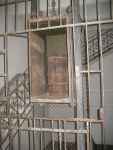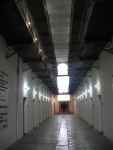

Tourists visiting Maramures (Romanian: Maramureş) – a northern region of Romania – should also visit, apart from picturesque villages with wooden architecture and old Orthodox churches, an interesting place associated with the Romania’s history. About 30 kilometres east from the village Sapanta known for its Merry Cemetery there is a city called Sighetu Marmației with a population of 45 thousand inhabitants. The city was first mentioned at the beginning of the 14th century and its name is probably derived from the Dacian word seget – a stronghold or from the Hungarian sziget – an island. During communist Romania’s existence there was a prison for political opponents here. After the collapse of Communism a museum commemorating the victims of Communism was here established.
ATTENTION! Everyone who visited Romania or is planning to go there soon is kindly invited to contribute to this guide. Any inquires regarding this matter should be referred to the editor's address redakcja@libertas.pl.
The museum is briefly called Memorial, but its whole name is The Memorial of the Victims of Communism and of the Resistance (the Romanian name is Memorialul Victimelor Comunismului şi al Rezistenţei). It was established in 2000 in the interior part of the former Sighet prison built by the Austo-Hungarian authorities in 1897.
Since 1945 the prison served, among other things, as a place of detention for former refugees from the Soviet Union. In August 1948 a group of students at different age and local farmers were imprisoned here. Some of them are still alive. In May 1950 more than one hundred people – the elite of the country including ministers, scientists, economists, officers, historians, journalists and politicians were put in the prison. Some of them had long prison sentences, the other ones had not been judged at all. Most of them were above 60 years old. In the autumn of the same year a group of 45-50 priests and bishops joined them. The prison was officially called ‘a unit for special labour’. In fact, it was a genocide place for the intellectual elite of the country. The living conditions in the prison were horrible. The prison cells were not heated; the prisoners were not allowed to lie on their bunks during the day. They were given starvation rations of food and had no opportunity to look through the window etc. Beating and humiliation were constant part of their prison lives. The writer Nicolae Steinhardt describes in his book entitled ‘Jurnalul Fericirii’ (‘The Diary of Happiness’) in a frightening way the persecution methods used in institutions of that kind. Apart from constant beating more ‘sophisticated’ chicaneries were used. So for instance some starving prisoners were given very hot grits to eat and were forced to drink very cold water afterwards which caused severe stomach pain (cramps). They were also allowed to eat as much as they could; then some dozen persons were put for several hours in a narrow room without access to a toilet. Such treatment was very humiliating to educated people being used to etiquette.
In 1955, after the Geneva Convention had been concluded and the UN had acknowledged the communist government of Romania an amnesty was proclaimed and some of the prisoners were released. The other ones were moved to another place while the rest had to stay under house arrest. 54 prisoners out of 200 died. In 1977 the prison was closed.
After the collapse of communism the Foundation called ‘Citizens Academy’ – a research and educational institution including also the former prisoners took measures in order to establish a special museum devoted to the fight against Communism. Its concept first appeared in 1992, one year later a project was submitted to the European Commission, and in the following year the first preparatory and construction work lasting till 2000 was initiated. The former prison was in a horrible condition; it was mouldy and completely destroyed. The reconstruction work included, i.a. drainage and elimination of dry rot, renovation of the foundations, roof replacement and painting.
At present the museum has a very interesting layout. Each prison cell is a separate exhibition hall or room devoted to a particular subject. We will find here examples of the original arrangement of the former cells with bunks, clothes and chains. There are exhibition rooms devoted to famous people who died in this place. The other ones remind of the fight against Communism in different countries. One exhibition hall commemorates the upsurge of the Polish movement ‘Solidarity’. Out from the posters Lech Wałęsa is looking at us; we can see pictures from the shipyard and strikes. There is a flag with the inscription ‘Solidarity’. A quite extensive description allows to understand what happened in Poland. In the museum there is a special exhibition hall being completely devoted to the former Romanian dictator Nicolae Ceausescu. We will see there small statuettes presenting the leader sitting, his wife and a great number of pictures from official visits and meetings. A hall presenting typical daily necessities in Romania in the 1960-ties and 70-ties including i.a. a bibelots shelf, a radio, gramophone or a pioneer uniform also looks very interesting.
In the inner courtyard there is a chapel designed in the style of early Christian catacombs. On the walls leading to the chapel the names of more than 8 thousand people who were killed in prisons and camps in Romania were engraved. Collecting all these names took more than ten years of efforts and this is still only a small part of these ones who were killed in their fight against Communism. In the next courtyard there is a sculpture presenting 18 naked figures with stretched shoulders. The figures are going towards the wall which, likewise the communist system, closes the horizon. This group has become a symbol of the museum.
After visiting the monasteries and charming villages surrounded by beautiful mountains the visit in the Memorial is like a nightmare. Still, it is worth everyone’s while if they want to learn the recent Romanian history. To the inhabitants of this country this place is of great symbolic significance and it attracts a great number of visitors.
The museum is located at Corneliu Coposu number 4 in Sighetu Marmaţiei. While driving along the main arterial road through the city center we will see a large banner – Memorial – hung above a side street on our right. The banner will show us the way to the museum. For further information (also in English) see: www.memorialsighet.ro
The museum is open (except Mondays) every day between 9.30 am and 6.30 pm (from 15th April to 15th October) and 9.30 am – 4.30. pm (from 16th October to 14th April).
Rumunia - przewodnik:
Satu Mare / Satmar (Romania) – guidebook (52 zdjęcia)Săpânţa - The Merry Cemetery (Romania) – guidebook (35 zdjęć)Bârsana Maramureş (Romania)– guidebook (48 zdjęć)Humor / Mănăstirea Humorului and Voronet / Voroneţ (Romania) – guidebook (32 zdjęcia)Arbore and Sucevita Monastery / Mănăstirea Suceviţa (Romania) – guidebook (43 zdjęcia)Cacica (Romania) – guidebook (21 zdjęć)Vama Veche (Romania) – guidebook (75 zdjęć)Brasov (Romania) – guidebook (68 zdjęć)Curtea de Argeş (Romania) – guidebook (31 zdjęć)The Transfagarasan Road / Transfăgărăşan – guidebook (68 zdjęć)Sibiu / Hermannstadt (Romania) – guidebook (86 zdjęć)Hunedoara / Vajdahunyad (Romania) – guidebook (57 zdjęć)Bear Cave / Peştera Urşilor (Romania) – guidebook (29 zdjęć)Ştefan Hruşcă – kolędnik z SiedmiogroduSighetu Marmației (Romania) – guidebook (9 zdjęć)Kościoły Obronne Siedmiogrodu (Rumunia) – przewodnik (25 zdjęć)Rimetea / Torocko at the Rock of Szeklers (Romania) – guidebook (21 zdjęć)Konstanca / Constanța (Rumunia) – przewodnik (22 zdjęcia)Sighișoara (Romania) – guidebook (28 zdjęć)Mărginimea Sibiului (Romania) – guidebook (41 zdjęć)Wąwóz Galbeny / Cheile Galbenei (Rumunia) – przewodnik (23 zdjęcia)Twierdza Ponoru / Cetatile Ponorului (Rumunia) – przewodnik (19 zdjęć)Płaskowyż Padisz / Padiș (Rumunia) – przewodnik (52 zdjęcia)Wąwóz Râmeț / Cheile Râmețului (Rumunia) – przewodnik (29 zdjęć)Góry Fogaraskie – wokół jeziora Bâlea (Rumunia) – przewodnik (24 zdjęcia)